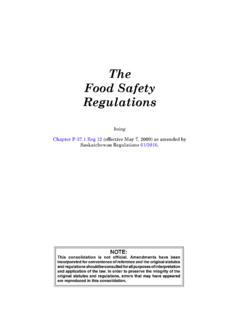Transcription of SAFETY DATA SHEET Salt - Intrepid Potash
1 SAFETY data SHEET salt Date Issued: November 3, 2004 Version: Revision Issued: March 2, 2017. section I Product and Company Identification Intrepid Potash MOAB, LLC. 707 17th St. Suite 4200. Denver, CO 80202. Office 303-296-3006. Fax 303-298-7502. Web EMERGENCIES: Call (800) 424-9300 (CHEMTREC). HEALTH EMERGENCIES: CONTACT YOUR LOCAL POSION CENTER. Common Name: Fine salt , Medium salt , Road Use: Animal Feed and Formula: NaCl Synonym: salt salt , Coarse salt Industrial section II Hazard Identification GHS07 Not Applicable Not Applicable Lab Elements: Prevention: Not Applicable Response: Not Applicable Not Applicable Storage: Not Applicable Not Applicable Disposal: Not Applicable Not Applicable section III Composition/Information on Ingredients Exposure Limits Chemical Name(s) CAS No.
2 OSHA PEL TLV - TWA STEL CEIL % by Weight mg/m3 ppm mg/m3 ppm mg/m3 ppm mg/m3 ppm Sodium Chloride 7647-14-5 15 / 5* 10** - Potassium Chloride 7447-40-7 15 / 5* 10** ** Total Dust / Respirable dust * Based on ACGIH nuisance dust limits section IV First Aid Measures Rinse cautiously with water for several minutes. Flush with water, including under upper & lower lids, for at least 15. Eyes: minutes. Remove contact lenses, if present and easy to do. Continue rinsing. Get medical attention/advice if pain and irritation persists. Skin: Wash thoroughly with water.
3 Obtain medical advice/attention if irritation persists. A large bodily load may cause vomiting, diarrhea, cramps, tingling in hands and feet, weak pulse, and circulatory Ingestion: disturbances. Administer water to the patient. Ingesting will usually cause purging of the stomach by vomiting. Get medical attention. If individual is experiencing respiratory discomfort or irritation remove to fresh air. If discomfort or irritation persists, Inhalation: get medical attention/advice. Page 1 of 5. section V Fire Fighting Measures Flash Point: None Auto-ignition Temperature: Not Applicable Lower Explosive Limit: Not Applicable Upper Explosive Limit: Not Applicable Extinguishing Media: As required for surrounding fire.
4 salt is non-flammable and does not support combustion. Full structural firefighting (bunker) gear is the minimum acceptable attire. The need for proximity, entry, flashover and/or special chemical protective clothing (see section 8) needs to be determined for each Special Firefighting incident by a competent firefighting SAFETY professional. Water used for fire suppression and cooling Procedures and Equipment: may become exposed to soluble fertilizer. Discharge to sewer system(s) or environment may be restricted, requiring containment and proper disposal of water.
5 section VI Accidental Release Measures Small Spill: Sweep up and use as ice melt if non-contaminated by foreign materials. Collect with appropriate equipment. If on a hard surface, sweep up residue with brooms. If on soil, remove and collect Large Spill: the top 5 cm of soil. salt is highly soluble and can be quickly diluted by relatively large amounts of water. Prevent spilled materials from entering sewers, storm drains and other unauthorized treatment drainage systems. salt which has entered a small non- permanent pond should be removed by pumping the pond dry.
6 If spill could potentially enter any waterway, including Release intermittent dry creeks, contact the local authorities. If in the , contact the US COAST GUARD NATIONAL. Notes: RESPONSE CENTER toll free number, 800-424-8802. In case of accident or road spill notify: CHEMTRECIN USA AT. 800-424-9300; CANUTEC in Canada at 613-996-6666; CHEMTREC in other countries at (International code) +1-703- 527-3887. See section xiii for disposal information and section XV for regulatory requirements. Large and small spills may have a Comments: broad definition depending on the user's handling system.
7 Therefore, the spill category must be defined at the point of release by technically qualified personnel. section VII Handling and Storage Ventilation: Local exhaust to reduce dust concentrations below recommended levels. Handling: Avoid generating dust by excessive or unnecessary movement. Storage: Store in a dry location. Avoid contact with aluminum or carbon steel to minimize corrosion. section VIII Exposure Controls/Personal Protection Engineering Controls: May be necessary to minimize dust levels. Personal Protection: Eye Protection: Use tight-fitting SAFETY goggles in areas of high dust concentration.
8 Protective Clothing: Gloves, long sleeve shirts and long pants. Launder work clothing regularly. Minimum NIOSH approved N95 filter type dust respirators until engineering controls are Respiratory Protection: implemented. Other Protective Clothing or Equipment: Optional section IX Physical and Chemical Properties Appearance/Color/Odor: White crystalline or granular. Melting Point/Range: 800 C (1472 F) Boiling Point: 1465oC (sublimates). Solubility in Water: 359 grams per liter Boiling Point/Range: 1420 1500oC. Specific Gravity: Vapor Pressure (mmHg): Not Applicable Vapor Density: Not Applicable % Volatiles: < Bulk Density: 35-83 (560-1330 kg/m3) Evaporation Rate: No data Available pH: Approximately 8 Viscosity: Not applicable Page 2 of 5.
9 section X Stability and Reactivity Stability: Stable. Hazardous Polymerization: Will not occur Conditions to Avoid: None Strong oxidizing agents, strong acids. In the presence of moisture it may be Materials to Avoid (Incompatibilities): mildly corrosive to metals. When heated to decomposition (above 1413 degree Celsius) may emit toxic Hazardous Decomposition Products: fumes of Na2O and Cl2. May evolve chlorine gas when in contact with strong acids. section XI Toxicological Information Significant Routes of Exposure: Eyes, skin, inhalation, ingestion Substance: Sodium Chloride Rat, oral, LD50 >3000 mg/kg Acute Oral Toxicity: Mouse, oral, LD50 > 4000 mg/kg Acute Inhalation Toxicity: Rat, LC50 > 42 g/m3 /1hour Acute Dermal Toxicity: No data available Rabbit, Eye: 100 mg/24 hour, moderate irritant Eye & Skin Irritation: Rabbit, Eye: 500 mg/ 24 hour, mild irritant Substance: Potassium Chloride Acute Oral Toxicity: No data available Acute Inhalation Toxicity.
10 No data available Acute Dermal Toxicity: No data available Eye & Skin Irritation: No data available section XII Ecological Information Acute Toxicity to Fish: 96 hour LC 50 2800mg/l (rainbow trout). Chronic Toxicity to Fish: No data available Acute Toxicity to Aquatic 48 hour EC50 337mg/l (Crustacean/Daphnia). Invertebrates: 96 hour LC 50 940mg/l (Physaheterostropha). Chronic Toxicity to Aquatic No data available Invertebrates: 72 hour ErC 50 2500mg/l Toxicity to Aquatic Plants: Ecotoxicology: NEOL g/l Toxicity to Bacteria: No data available (activated sludge): Toxicity to Soil Dwelling No data available Organisms: Toxicity to Terrestrial Plants: No data available Dissolves in water and disassociates into Na and Cl ions.





